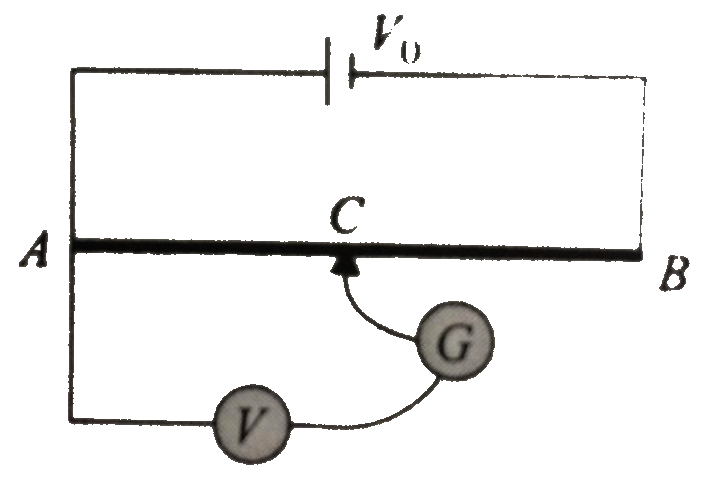Is the resistance of a voltmeter greater than or less that of the galvanometer of which it is formed?
To determine whether the resistance of a voltmeter is greater than or less than that of the galvanometer from which it is formed, we can follow these steps:
1. Understand the Components:
- A galvanometer is an instrument used to detect and measure small electric currents. It has a certain resistance, denoted as Rg.
- A voltmeter is used to measure the potential difference (voltage) across two points in a circuit.
2. Conversion of Galvanometer to Voltmeter:
- To convert a galvanometer into a voltmeter, we add a high resistance R in series with the galvanometer. This is necessary to ensure that the voltmeter draws minimal current from the circuit, allowing for accurate voltage measurements.
3. Resistance in Series:
- When resistors are connected in series, the total or equivalent resistance Rv of the circuit is the sum of the individual resistances:
Rv=Rg+R
- Here, Rg is the resistance of the galvanometer, and R is the resistance added in series.
4. Choosing the Series Resistance:
- The resistance R that we add must be significantly larger than the resistance of the galvanometer Rg to ensure that the voltmeter behaves as an ideal voltmeter. For an ideal voltmeter, the resistance should be infinite, but practically we aim for a very high resistance.
5. Comparing Resistances:
- Since R is much greater than Rg (i.e., R≫Rg), we can approximate the total resistance of the voltmeter:
Rv≈R
- Therefore, we conclude that:
Rv≫Rg
6. Conclusion:
- The resistance of the voltmeter Rv is indeed greater than the resistance of the galvanometer Rg from which it is formed.
Final Answer:
The resistance of a voltmeter is greater than that of the galvanometer from which it is formed.
- A galvanometer is an instrument used to detect and measure small electric currents. It has a certain resistance, denoted as Rg.
- A voltmeter is used to measure the potential difference (voltage) across two points in a circuit.
- To convert a galvanometer into a voltmeter, we add a high resistance R in series with the galvanometer. This is necessary to ensure that the voltmeter draws minimal current from the circuit, allowing for accurate voltage measurements.
- When resistors are connected in series, the total or equivalent resistance Rv of the circuit is the sum of the individual resistances:
Rv=Rg+R
- Here, Rg is the resistance of the galvanometer, and R is the resistance added in series.
- The resistance R that we add must be significantly larger than the resistance of the galvanometer Rg to ensure that the voltmeter behaves as an ideal voltmeter. For an ideal voltmeter, the resistance should be infinite, but practically we aim for a very high resistance.
- Since R is much greater than Rg (i.e., R≫Rg), we can approximate the total resistance of the voltmeter:
Rv≈R
- Therefore, we conclude that:
Rv≫Rg
- The resistance of the voltmeter Rv is indeed greater than the resistance of the galvanometer Rg from which it is formed.
The resistance of a voltmeter is greater than that of the galvanometer from which it is formed.
Topper's Solved these Questions
- BOOK - AAKASH SERIESCHAPTER - ELECTROMAGNETICSEXERCISE - PROBLEMS (LEVEL -I)40videos
ELECTROMAGNETICS
- BOOK - AAKASH SERIESCHAPTER - ELECTROMAGNETICSEXERCISE - PROBLEMS (LEVEL -II)40videos
ELECTROMAGNETICS
- BOOK - AAKASH SERIESCHAPTER - ELECTROMAGNETICSEXERCISE - EXERCISE (SHORT ANSWER QUESTIONS)6videos
ELECTROMAGNETICS
- BOOK - AAKASH SERIESCHAPTER - ELECTROMAGNETIC WAVESEXERCISE - EXERCISE -II22videos
ELECTROMAGNETIC WAVES
- BOOK - AAKASH SERIESCHAPTER - ELECTROSTATICSEXERCISE - ADDITIONAL PRACTICE EXERCISE (PRACTICE SHEET (ADVANCED) INTEGER TYPE QUESTIONS)5videos
ELECTROSTATICS
Similar Questions
The resistance of an ideal voltmeter is
View Solution(A) : The resistance of voltmeter is very small as compared to the resistance of the galvanometer, from which it is obtained.
(R) : The voltmeter is connected in series to the conductor across which potential difference is to be measured.View SolutionIn a galvanometer 5% of the total current in the circuit passes through it. If the resistance of the galvanometer is G, the shunt resistance 'S' connected to the galvanometer is
View SolutionShow that i is neither 0, nor greater than 0, nor less than 0
View SolutionA voltage V0 is applied to a potentiometer whose sliding constant is exacly in tne middle. A voltmeter V is connected between the sliding constant and one fixed end of the potentionmeter. If is assumed that the resistance of the voltmeter is not very high in comparison to the resistance of the potentiometer wire. What voltage will the voltmeter show : higher than, less than, or equal to V0/2?
 View Solution
View SolutionWhen a current of 5mA is passed through a galvanometer having a coil of resistance 15Ω, it shows full sacle deflection. The value of the resistance to be put in series with the galvanometer to convert it into a voltmeter of range 0−10V is:
View SolutionA galvanometer has a resistance of 100Ω. A current of 10−3A pass through the galvanometer. How can it be converted into (a) ammeter of range 10 A and (b) voltmeter of range 10v.
View SolutionGiven diagram resistance of voltmeter is 10kohm. Find reading of voltmeter.
 View Solution
View SolutionA galvanometer can be converted into either an ammeter or a voltmeter. Before conversion, which of the following thing about the galvanometer you are required to know.
i) Resistance of the galvanometer
ii) The magnetic field in which the coil is rotating
iii)Current for full scale deflection of galvanometer
iv) Nature of its constructionView SolutionIn the given circuit, the voltmeter records 5 V. The resistance of the voltmeter in Ω is
 View Solution
View Solution
